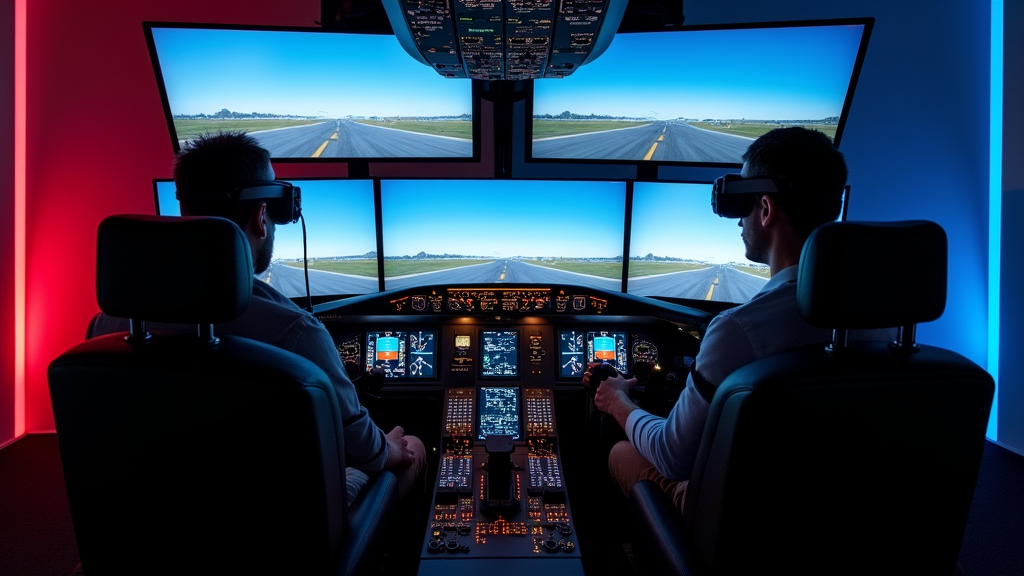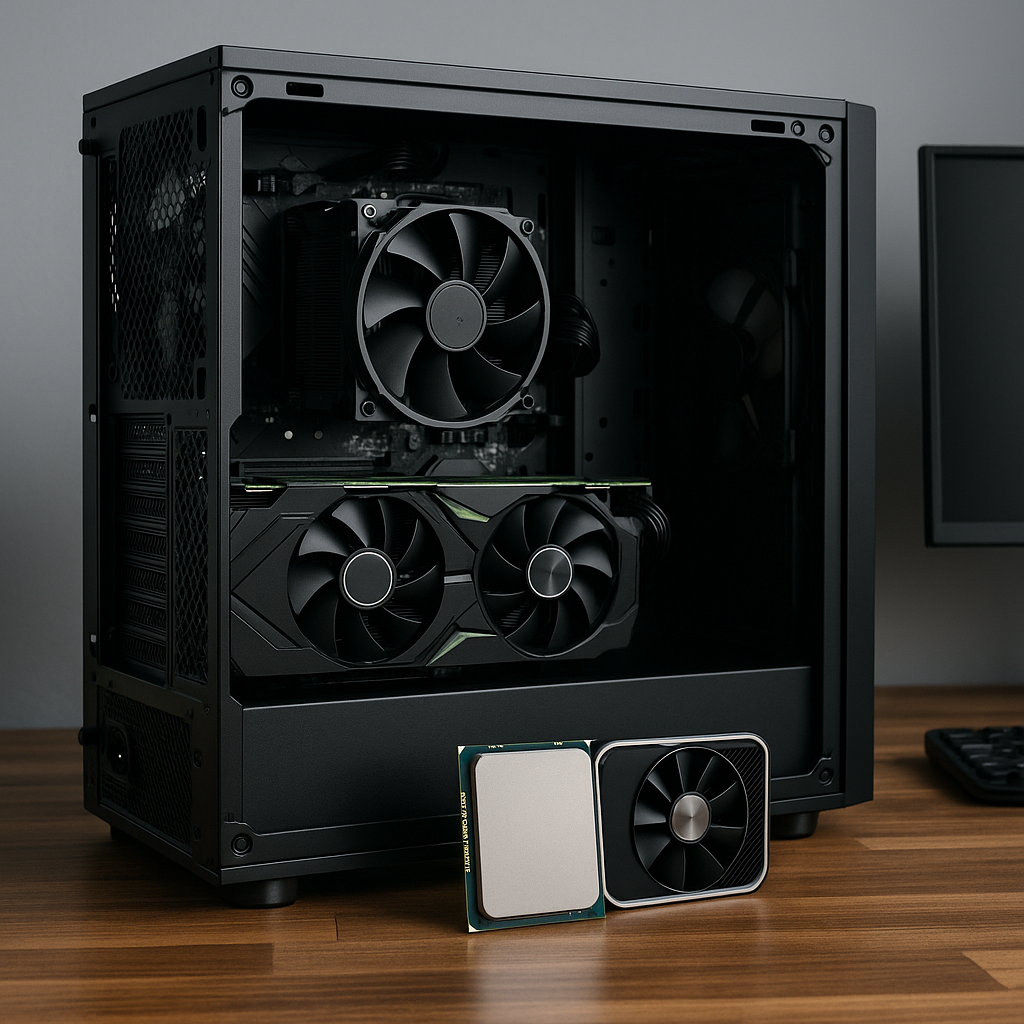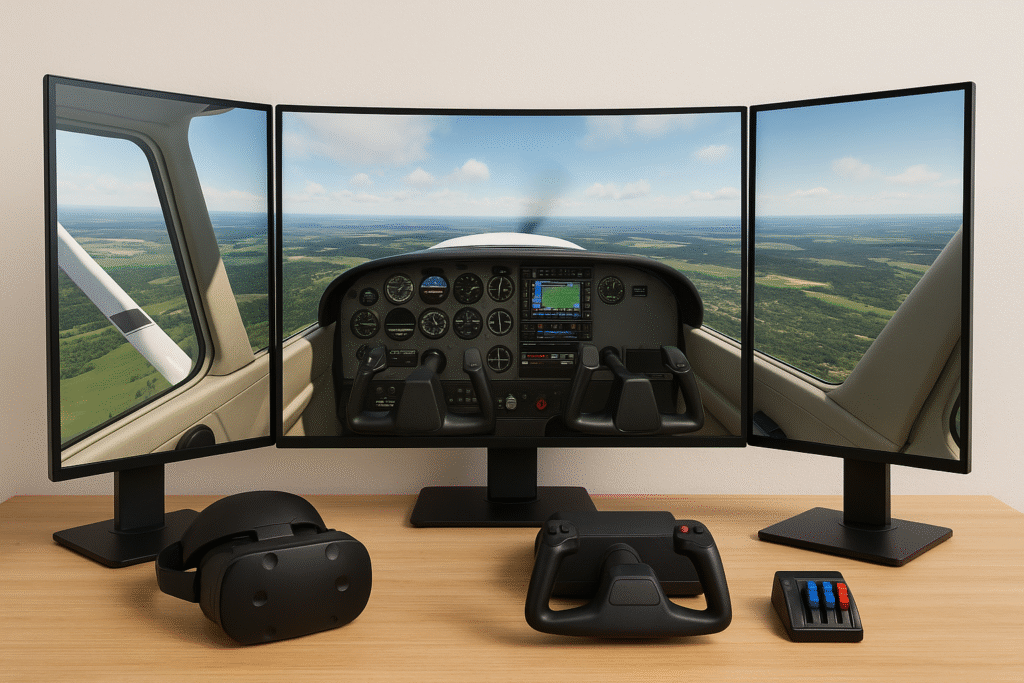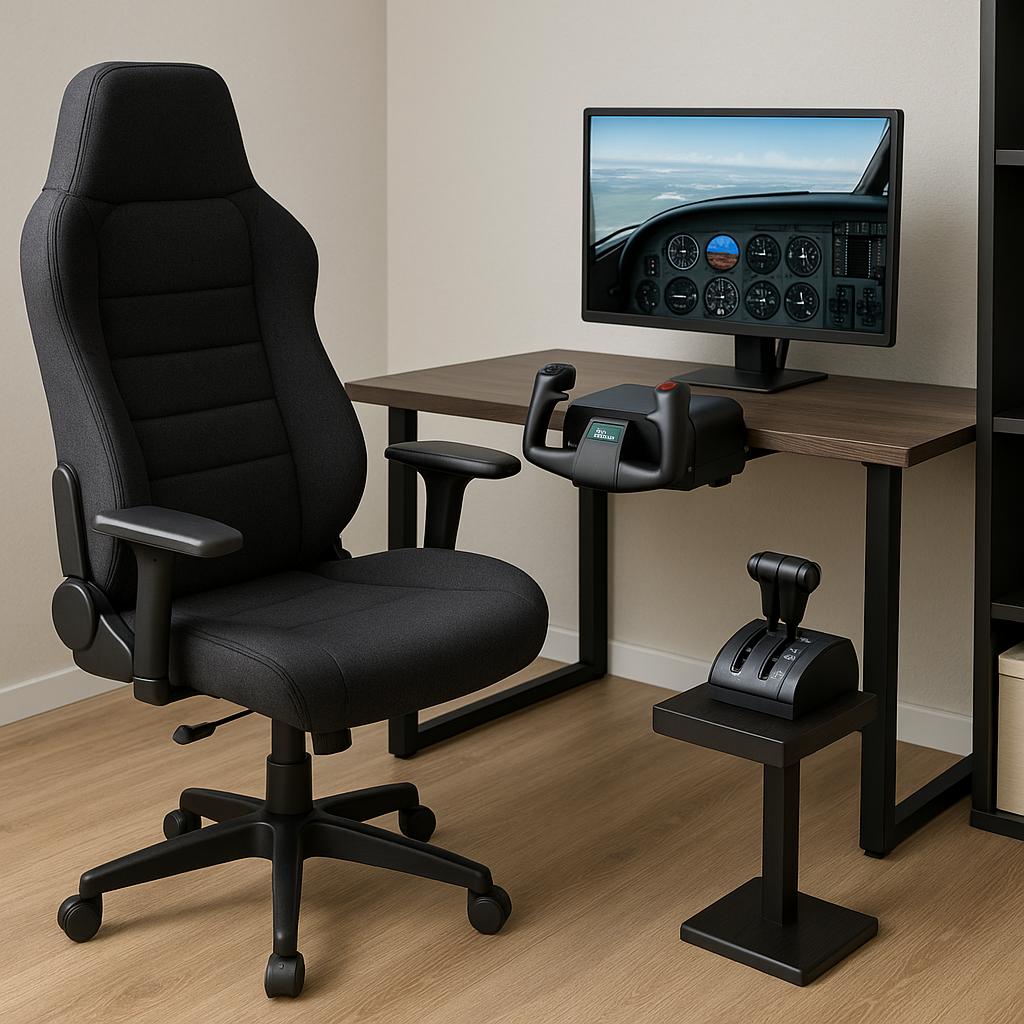Last updated on May 23rd, 2025 at 10:37 pm

Upgrading your flight simulator setup is one of the most exciting parts of the hobby. Whether you’re just starting out or you’ve been flying virtual skies for years, the right hardware can transform your experience from “good enough” to truly immersive. But with so many options on the market, it’s easy to wonder — where should you invest first? In this guide, I’ll walk you through the essential hardware upgrades that can make a meaningful difference in your setup, helping you get smoother performance, better visuals, and a cockpit that feels as close to real as it gets. If you’re just starting out, I recommend checking out our Getting Started With Flight Simulation: A Step-by-Step Guide for a smooth introduction to the hobby.
✈️ Core Components of an Upgraded Flight Sim Setup
Upgrading your flight sim hardware can transform your entire experience. It’s not just about higher specs — it’s about creating an environment that feels immersive, smooth, and exciting every time you take off. Whether you’re practicing landings, exploring global scenery, or flying with a virtual airline, the right gear helps you push the limits of realism and enjoyment.
Hardware Foundations

A great sim experience starts with powerful, reliable hardware. Flight simulators are demanding — they need a strong CPU to handle physics, weather, and aircraft systems, and a good GPU to deliver beautiful visuals and smooth frame rates. I recommend looking at CPUs like Intel’s i9 or AMD’s Ryzen 9 series and pairing them with a modern graphics card, like the NVIDIA RTX 40 series or AMD Radeon RX 7000 series, especially if you’re aiming for high settings or VR.
That said, you don’t need to start with top-of-the-line components. A good mid-range CPU like an Intel i5 or Ryzen 5 can still deliver solid performance, especially if you’re flying default aircraft or using fewer scenery add-ons. Many simmers start with a budget-friendly build and gradually upgrade as their experience (and sim demands) grow. Moving to a more powerful CPU later on can noticeably improve frame rates and overall smoothness — especially in dense airports or challenging weather conditions.
If you’re not ready to invest in a high-end GPU right away, don’t worry — many flight sims still run well on mid-range cards like the NVIDIA RTX 3060 or AMD RX 6700 XT. You may need to dial down some settings like shadows or terrain detail, but you can still enjoy a visually impressive experience. As you expand your sim with VR, multiple monitors, or ultra-detailed scenery, upgrading to a higher-tier GPU will help maintain smooth, immersive performance.
When it comes to memory, 32GB of RAM is a solid starting point for most simmers. If you’re planning to run multiple monitors, heavy add-ons, or ultra-detailed scenery, bumping up to 64GB can make a noticeable difference. And don’t overlook storage — installing your sim on an NVMe SSD cuts load times dramatically and keeps performance smooth even in complex environments.
If you’re building on a budget, even 16GB of RAM can get you started — especially for lighter setups or older sim platforms. Just keep in mind that more demanding add-ons and modern simulators like MSFS 2020 benefit from having extra memory available. Upgrading to 32GB or even 64GB later can help reduce stutters and load times in complex environments.
Display Dynamics

Visual immersion is where a lot of the magic happens. The display choices you make can turn your desk into a real training cockpit or a race team’s pit. Here’s what tends to make the biggest difference:
- Monitors: A single large, high-refresh monitor is a nice upgrade, but going for a triplemonitor setup stretches your view out and adds a ton of realism. Ultrawide monitors are also pretty handy for flight and racing sims, offering a seamless panoramic perspective.
- Virtual Reality (VR): VR headsets like the Meta Quest, HP Reverb G2, or Valve Index add real depth and immersion. Being able to look around the cockpit naturally, check your instruments, and gauge spatial awareness makes it feel a lot more like real flying. Just make sure your PC can keep up!
Control Systems

Nothing boosts immersion like quality controls. Whether you fly general aviation, airliners, or military jets, the right yoke, joystick, and throttle quadrant make your cockpit feel alive. I remember upgrading from a keyboard to a joystick — it completely changed how I connected with the aircraft and made flying so much more enjoyable. A yoke is great for airliners and Cessnas, while a joystick shines for fighter jets or aerobatic flying. If you’re still deciding between a yoke and joystick, check out Understanding Yokes Vs. Joysticks: What’s Right For You? for detailed advice. Adding rudder pedals is another game-changer — they bring realism to taxiing, coordinated turns, and crosswind landings. For tips on choosing the right rudder pedals, check out How To Select The Right Rudder Pedals For Your Simulator. For extra convenience, button boxes and switch panels help streamline your workflow, so you can spend less time hunting for keyboard shortcuts and more time focused on the skies.
Simulation Software
Upgrading software isn’t just about new platforms; it’s also about picking out add-ons and mods that ramp up the realism. Here’s what I find really pushes the envelope for sim fans:
- Platform Choice: Popular options like Microsoft Flight Simulator, X-Plane, and Prepar3D each have strengths. MSFS brings photoreal visuals, X-Plane offers really good flight models, and P3D is known for detailed add-ons and system depth. Your PC’s specs and your own preferences matter here.
- Add-ons & Mods: Aircraft packs, realistic airports, global scenery, weather engines, and ATC enhancements all help personalize your sim. I keep an eye on trending sites like SimMarket, Orbx, and the official marketplace for new releases.
- Weather Simulation: Real world, dynamic weather increases unpredictability and challenge. Third party tools can pull real data into your sim, ensuring conditions match what’s happening outside right now.
You can also explore our roundup of Essential Software And Tools For Novice Pilots to enhance your setup.
Audio Upgrades
It’s easy to overlook audio, but rich soundscapes drag you deeper into the adventure. Engine rumble, wind noise, switches clicking, and detailed radio chatter all add layers to the environment. Tracking down great audio gear can really give a boost to the simulation:
- Sound System: Surround sound speakers bring your cockpit alive, and high quality headphones offer fantastic clarity, especially for engine sounds and air traffic control. You actually notice more details from both near and far.
- Audio Software: Plugins or mods sometimes give a boost to ATC, engine, and ambient sounds, letting you tune audio profiles and improve how the world feels around you.
Ergonomics & Comfort

Sessions can run for hours, especially when time seems to fly by mid-route. Upgrades for comfort are just as important as any tech spec. Here’s what helps keep me relaxed and focused through even the most challenging flights:
- Seating: An adjustable, well cushioned chair makes a huge difference. Racing style seats and premium office chairs with lumbar support are both really popular with sim fans. Poor seating leads to fatigue; it’s worth getting right.
- Lighting: Bias lighting behind your monitors reduces eye strain, and colored ambient lighting (like LED strips) adds flavor while making the room more immersive and less harsh on your eyes during long flights or races.
If you’re interested in a more immersive setup, don’t miss our article on Building A DIY Home Cockpit On A Budget.
Network & Connectivity
Many simulations have moved partly or fully online, so your connection has to keep up. Here’s what keeps everything smooth and opens up new ways to play:
- Internet: A reliable, highspeed connection helps with cloud based weather, multiplayer sessions, regular updates, and access to live traffic data.
- Online Communities: Flying with virtual airlines, taking part in race leagues, or joining Discord servers is a fun way to meet new friends, learn fresh skills, and stumble upon special events. Community content and support add a lot of variety, too.
Future-Proofing
Simulation technology moves quickly, so planning ahead can save you both money and hassle. Here’s what helps your setup stay up to speed as tech gets better:
- Scalability: Modular gear and upgradeable PCs let you swap in new parts or expand down the road, instead of starting over from scratch.
- Emerging Tech: Keeping an eye on trends like next gen VR headsets, improved force feedback controls, and smarter AI traffic means you’ll always be ready for the latest features as they hit the market.
Common Questions About Sim Hardware Upgrades
Question: What’s the first thing I should upgrade?
Answer: If your visuals stutter or take forever to load, start with a GPU and SSD upgrade. For realism, grabbing a better yoke, joystick, or VR headset makes a bigger impact on how the simulator feels.
Question: Is VR really worth the investment for flight or racing sims?
Answer: VR takes immersion to another level when your PC can handle it. Depth perception, full head movement, and cockpit awareness are all way better in VR, but make sure to check for motion sickness and comfort before locking yourself in long term.
Question: Do I need to spend thousands to get a good setup?
Answer: You can upgrade over time. Adding new controls, improving your monitor, or installing an SSD each makes a big difference. No need to do everything at once, unless you want to!
Real World Experiences & Final Thoughts
At the end of the day, upgrading your sim isn’t just about chasing the latest specs or flashy gear — it’s about building a setup that deepens your enjoyment and connection to virtual aviation. Whether it’s a faster GPU, a set of rudder pedals, or a simple monitor upgrade, each improvement brings you one step closer to a more realistic and satisfying flight experience. Take your time, upgrade in phases, and most importantly, enjoy the journey. After all, flight simulation is about more than just hardware — it’s about the love of flying and the adventures you create in the virtual skies.

This is something I’ve always wanted to experience ever since I heard about simulation products. I am more of a racing enthusiast but now that I’ve come across this article I can definitely see my self adding flying to my list of simulation products I’d like to try. Is there a big price difference between buying Flight simulator products and upgrades vs racing simulator products and upgrades? I can see from the photos in this article that, there is going to be a few more pieces of equipment to buy but I’m not really sure about how much more it would cost me.
Thanks again for your comment, Jason! You’re right—flight simulation gear can be a bit more expensive, especially when you start adding things like yokes, rudder pedals, and throttle quadrants. But it really depends on how deep you want to go—just like with racing sims, there are entry-level and high-end setups. Since you’re already into racing sims, I think you’d really enjoy the flying side of things too. Definitely worth trying out one day!
Hello MElamin!
This was such a fun and informative read! I’ve been toying with the idea of diving deeper into flight simulators, but honestly, the hardware side of things always intimidated me a little. Your breakdown of essential upgrades was super helpful—it made the whole setup process feel a lot more approachable.
I especially liked how you explained the impact of each component on the simulation experience. The tip about upgrading the yoke and rudder pedals really caught my attention—I had no idea they could make such a difference in realism! Have you found any particular brands or setups that strike a good balance between performance and affordability for beginners?
Thanks again for the great guide—now I’m even more excited to elevate my sim experience!
Angela M 🙂
Hi Angela,
I’m really glad you enjoyed the guide—and it’s great to hear you’re thinking about diving deeper into flight simulation! You’re absolutely right—hardware can seem intimidating at first, but once you break it down, it becomes much more manageable (and even fun to explore).
For beginners, there are definitely some solid accessories that strike a nice balance between performance and affordability. For example, the Logitech G Flight Yoke System and the Thrustmaster T16000M FCS HOTAS are both great entry points. They offer decent build quality and functionality without requiring a huge investment. Once you’re more comfortable and want to upgrade, brands like Honeycomb and VKB are worth checking out for a more premium experience.
It’s smart to start with beginner-friendly gear and then scale up as your skills and preferences evolve. Glad the guide helped make things feel more approachable—and feel free to reach out anytime if you have more questions along the way!
Happy flying,
MElamin ✈️
To enhance your simulation (sim) experiences, key hardware upgrades include investing in a high-refresh-rate monitor (144Hz or higher) for smoother visuals, a powerful GPU (like an NVIDIA RTX 3070 or better) to handle detailed graphics, and a force-feedback steering wheel or flight stick for immersive control. Additionally, upgrading to a multi-core CPU (such as an AMD Ryzen 7 or Intel i7) ensures seamless physics calculations, while adding VR headsets like the Meta Quest 3 or Valve Index can take immersion to the next level. Don’t overlook peripherals—load cell pedals, buttkickers for tactile feedback, and a sturdy sim rig can drastically improve realism. Have you tried any of these upgrades, or do you have recommendations based on your own setup? Share your experiences!
You’re absolutely right—those hardware upgrades can really elevate the simulation experience. I agree that a powerful PC is essential, but it doesn’t always have to be top-of-the-line—just meeting the system requirements can already make a big difference.
I tried running Microsoft Flight Simulator 2020 on my current setup, but it didn’t meet the minimum requirements, so I’ll definitely need to upgrade to a proper gaming PC one day. As for peripherals like load cell pedals or buttkickers, I think those can come later once the core system is ready. Starting with the right foundation makes future upgrades much smoother.
Thanks again for the detailed insight!